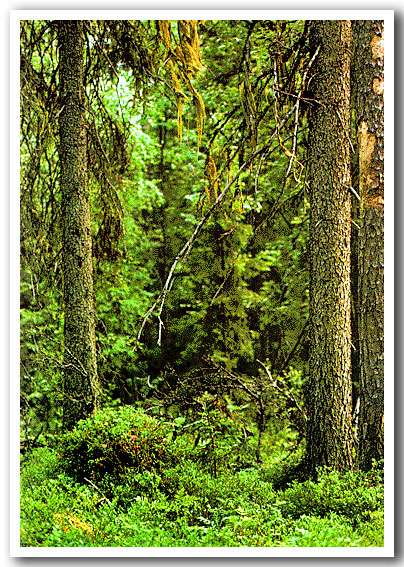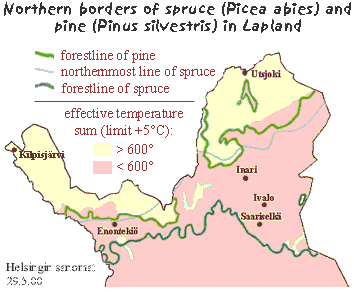

Forests (the first section)
Typical features of northern (= boreal) (taiga)forests: |
- Tree stand is sparse, low and slow-growing, few tree species. - Undergrowth is often thick and dense (dwarf shrubs, mosses and lichens are common), but the diversity is often low. - Many evergreen species especially in coniferous forests. - Nutrient-poor soil, slow nutrient cycle, herb-rich woodlands are relatively rare andpodsol is common. - Phytomass and annual nettoproduction of forests are rather small - Taigametsien eläinlajistokin on aika niukka. Hapan maaperä ja havupuiden pihkaiset neulaset eivät tarjoa ravintoa monillekaan eläinlajeille. (Lauhkean lehtmetsävyöhykkeen metsissä on aivan toisenlainen tilanne!). The climatic factors have essential stake to these features. |

(Above): EMT -forest dominating by scots pine (Pinus sylvestris) and
lingonberry (Vaccinium vitis-idaea).
- Kuusamo, Ajakanniemi.
(Above): Old EMT -forest, where spruce (Picea abies) and labrador tea (Ledum palustre).
There are abundantly lichens (Alectoria and Bryoria) on the trunks of a pines,
where the reindeers have eaten all until so up they reach to eat in winter on the snow. See: reindeer!

(Above): Hylocomium-Myrtillus Type old spruce forest (so called thick moss type.
- Kuusamo, Ampumavaara.
(There are the phytomasses of this old HMT-forest in a part of 'Plant ecology'.)
The highest forests of Riisitunturi-fjeld (in Posio), close to the forestborder,
are like in this picture: unproductive and trees are growing scattered.
Forest type is dickmosstype (HMT= Hylocomium-Myrtillus-Type).
The trees - spruces and pines, too - are broken by snow (so-called 'tykky'-trees).
More pictures of 'tykky'-trees, see: picture 2, picture 3, picture 4, picture 5, picture 6, picture7 and picture 8!
The forests in northern Finland - especially in Fjeld Lapland and in Forest Lapland - are in many respects different from forests of southern Finland |
 Boreal forests (= northern coniferous forests, taigaforests) in Finland can be divided into four sub-zones: Forest Lapland (= Metsälappi), Southern Lapland (= Peräpohjola), Ostrobothnia (= Pohjanmaa) and Southern Finland (= Etelä Suomi). (See map "The forest vegetation zones of Finland"!)
Boreal forests (= northern coniferous forests, taigaforests) in Finland can be divided into four sub-zones: Forest Lapland (= Metsälappi), Southern Lapland (= Peräpohjola), Ostrobothnia (= Pohjanmaa) and Southern Finland (= Etelä Suomi). (See map "The forest vegetation zones of Finland"!)
Towards the north, the spruce (Picea abies) disappears first, and finally Scots pines (Pinus silvestris) start to be rare too (see below the map of "Northern borders..."!). However, Scots pines disperse to the northernmost parts of Finland through northern river valleys from the coastal areas of the "warm" Arctic Ocean. There are only a few Scots pine stands in the Petsikko area between Utsjoki and Inari, the mountain birch (Betula *tortuosa) dominate.
The Fjeld Lapland (= Tunturilappi; see the map of the vegetation zones of Finland) is mainly mountain birch dominated (see the section "Fjelds").The undergrowth vegetation of the mountain birch forests does not differ much from other northernmost forests. Even the flora on the bare fjeld tops (= tunturipaljakka) resembles somewhat the undergrowth flora of coniferous forests.
The oak forest zone (= Tammivyöhyke) in the south and Fjeld Lapland (= Tunturilappi) in the north are intermediates between the different zones of vegetation (see the geobotanical map of Scandinavia and the vegetation zones of Lapland).
The borderlines of different forest types are basically the same as the borderlines of different peatlands (= mires) types.
Of the forests of Finland about 50% are pine dominant, 30% spruce dominant and 7% birch dominant. In the north there are a lot of pine dominant forests when in the south the forests are spruce dominant. Of course there are regional differences: in the southern part of our country there are more mesic coniferous forests than dry ones and the opposite in the north.
The amount of coppice like forests in southern Finland is about 10% and in the northern Finland only about 2%. The amount of coppices (real eutrophic forests (in Finnish = lehto) in southern Finland is about 1% and in northern Finland only a trace.
The forest zones in Lapland (map) are in this map a some different than in a map of forest vegetation zones of all Finland. In addition to this the orohemiarctic areas (= areas over forestsline, alpine) are marked here.
The forest- and timberlines are moved meny times since the ice age, when the climate has changed. The forestline is dynamic!
The timberline in north has been changing after the Ice Age because of the climate changes. In the fell lakes of Lapland - above the present timberline - there are thousands of years old pine trunks, memories from the earlier timberlines.
The timberlines is dynamic and different tree species has different lines (see map below!). The timberline in north has been changing after the Ice Age because of the climate changes. In the fell lakes of Lapland - above the present timberline - there are thousands of years old pine trunks, memories from the earlier timberlines.
At the forestline the trees are growing rather close together ('a squirrel can jump from ane tree to other tree'), but at the timberline the trees are far apart, they are low and damaged by the crown snow (in Finnish: tykkylumi).
The low temperature sum and the long, snowy wintertime are the most important ecological factors affecting to the forest- and timberlines in Lapland. You can see in the map, that the forests are not thriving, if the effectve temperature sum is under +600°C.
A little more about the forestline!


The so-called "protected forest zone" (= in Finnish: suojametsäalue) is situated in northern Lapland (map above, right). It consists mainly of the forests of the mountain area (the vegetation zones of Lapland!), where the re-growth of forests has turned out to be very difficult (e.g. after deforestation or forest fires).
Most of all protected forests and forestsoils are situated in Lapland, see also statistics of endangered nature! It is difficult to realize protection in South-Finland, because the main part of southern forests are private-owned (in North-Finland mostly state-owned).
Here: Forests (the second section)
Other sections: Main menu (on the upper part of this screen)!